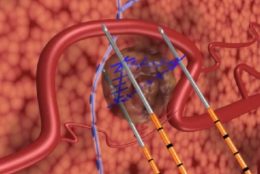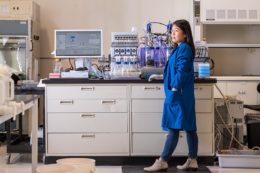Posts Tagged ‘research’
Rempel leads study on electric vehicle charging stations
A study led by Professor Emeritus David Rempel and the environmental non-profit group Cool the Earth tested the functionality of 657 EVSE (electric vehicle service equipment) connectors at all 181 open public, non-Tesla charging stations in the Bay area. The study found that 27% were nonfunctional, a concerning issue for the widespread adoption of electric vehicles.
Read MoreSolar beats nuclear at many potential settlement sites on Mars
Research by BioE PhD student Aaron Berliner and Prof Adam Arkin shows that photovoltaics could provide all the power needed for an extended mission to Mars, or even a permanent settlement there. The authors are members of the Center for the Utilization of Biological Engineering in Space (CUBES), led by Adam Arkin.
Read MoreKumar and Schaffer discover how biomaterials regulate stem cell neurogenesis in 3D
Engineered biomaterials are increasingly used to expand and differentiate stem cells for technological and therapeutic applications. A major open question in the field is how the mechanical properties of material scaffolds regulate stem cell differentiation, especially in complex 3D geometries like those found in tissue. In a collaborative study published in Science Advances, the labs of Sanjay Kumar and David Schaffer have discovered a 3D-specific molecular mechanism through which mechanical inputs act through the transcription factor Egr1 to determine how efficiently neural stem cells turn into neurons.
Read MoreNow fully complete, human genome reveals new secrets
Nearly 20 years after the sequencing of the human genome, a large team of researchers has finally filled in the remaining few percent of unsequenced DNA, providing the first complete, gapless human genome. First author of many of the suite of papers is Nicolas Altemose, 2021 bioengineering PhD and current postdoc with co-author Professor Aaron Streets.
Read MoreUndergraduate Alexandra Potter first author on lung cancer screening paper
Undergraduate bioengineering student Alexandra Potter has been a long-term collaborator with Dr. CJ Yang of Harvard University on the effectiveness of lung cancer screening. Today she is first author on a paper published in the British Medical Journal, “Association of computed tomography screening with lung cancer stage shift and survival in the United States.” Potter is also CEO of the American Lung Cancer Screening Initiative.
Read MoreYartsev shows a stable hippocampal code in freely flying bats
Neural activity in the hippocampus is known to reflect how animals move through an environment. Using innovative wireless miniature microscopy technology in flying bats, Professor Michael Yarsev’s lab has resolved a long-standing scientific debate about the stability of those neural codes.
Read MoreNHS begins use of BioE-pioneered Nanoknife
Non Thermal Irreversible Electroporation treatment, developed by Bioenginering and Mechanical Engineering professor Boris Rubinsky, is now the technology behind the Nanoknife. Licensed from Berkeley by AngioDynamics, the Nanoknife uses electric currents to quickly and easily reach remote tumors in prostate cancer. University College London Hospital was recently the first hospital to use the treatment in…
Read MoreCRISPR-Chip named 2021 Top 10 Innovation by The Scientist
Developed by former BioE postdoc Kiana Aran, the CRISPR-Chip now in use in Cardea Bio’s CRISPR-SNP-Chip has been named one of 2021’s Top 10 Innovations by The Scientist magazine. The new chip is the first device capable of detecting single base differences in DNA without generating millions of copies of the DNA first.
Read MoreThe greener route to indigo blue
Alumna Tammy Hsu is finding a way to produce fabric dye with a lower environmental impact – feature article in Nature online.
Read More






